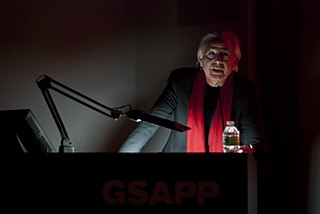
Arthur Charles Erickson, was a Canadian architect and urban planner. He studied Asian languages at the University of British Columbia, and later earned a degree in architecture from McGill University.

Bernard Tschumi is an architect, writer, and educator, commonly associated with deconstructivism. Son of the well-known Swiss architect Jean Tschumi and a French mother, Tschumi is a dual French-Swiss national who works and lives in New York City and Paris. He studied in Paris and at ETH in Zurich, where he received his degree in architecture in 1969.

Peter Eisenman is an American architect. Considered one of the New York Five, Eisenman is known for his writing and speaking about architecture as well as his designs, which have been called high modernist or deconstructive.

Dame Zaha Mohammad Hadid was an Iraqi-British architect.

Lina Bo Bardi, bornAchillina Bo was an Italian-born Brazilian modernist architect. A prolific architect and designer, she devoted her working life, most of it spent in Brazil, to promoting the social and cultural potential of architecture and design. While she studied under radical Italian architects, she quickly became intrigued with Brazilian vernacular design and how it could influence a modern Brazilian architecture. During her lifetime it was difficult to be accepted among the local Brazilian architects, because she was both a "foreigner" and a woman.

Postmodern architecture is a style or movement which emerged in the 1960s as a reaction against the austerity, formality, and lack of variety of modern architecture, particularly in the international style advocated by Le Corbusier and Ludwig Mies van der Rohe. The movement was introduced by the architect and urban planner Denise Scott Brown and architectural theorist Robert Venturi in their book Learning from Las Vegas. The style flourished from the 1980s through the 1990s, particularly in the work of Scott Brown & Venturi, Philip Johnson, Charles Moore and Michael Graves. In the late 1990s it divided into a multitude of new tendencies, including high-tech architecture, modern classicism and deconstructivism.

The Graduate School of Architecture, Planning and Preservation at Columbia University in New York City, also known simply as GSAPP, is regarded as one of the most important and prestigious architecture schools in the world. It is also home to the well-regarded Masters of Science program in Urban Planning, Urban Design, Historic Preservation, and Real Estate Development.
Thom Mayne is an American architect. He is based in Los Angeles. In 1972, Mayne helped found the Southern California Institute of Architecture (SCI-Arc), where he is a trustee. Since then he has held teaching positions at SCI-Arc, the California State Polytechnic University, Pomona and the University of California, Los Angeles (UCLA). He is principal of Morphosis Architects, an architectural firm in Culver City, California. Mayne received the Pritzker Architecture Prize in March 2005.
Roots of Resistance was an ostensibly anti-racist organization active in Vancouver, British Columbia, Canada from 1992 to 1996. The organization was formed shortly after a Vancouver demonstration in support of Rodney King during the 1992 Los Angeles riots, fusing an affinity group called Anarchists of Colour with Langara College's students of colour collective, the Third World Alliance, and other activists. Roots of Resistance was composed of people of colour only, with members of African, Asian, First Nations and Latin American ancestry, including people of mixed-race.
Romaldo "Aldo" Giurgola AO was an Italian academic, architect, professor, and author. Giurgola was born in Rome, Italy in 1920. After service in the Italian armed forces during World War II, he was educated at the Sapienza University of Rome. He studied architecture at the University of Rome, completing the equivalent of a B.Arch. with honors in 1949. That same year, he moved to the United States and received a master's degree in architecture from Columbia University. In 1954, Giurgola accepted a position as an assistant professor of architecture at the University of Pennsylvania. Shortly thereafter, Giurgola formed Mitchell/Giurgola Architects in Philadelphia with Ehrman B. Mitchell in 1958. In 1966, Giurgola became chair of the Columbia University School of Architecture and Planning in New York City, where he opened a second office of the firm. In 1980 under Giurgola's direction, the firm won an international competition to design a new Australian parliament building. Giurgola moved to Canberra, Australia to oversee the project. In 1989, after its completion and official opening in 1988, the Parliament House was recognized with the top award for public architecture in Australia.

Catherine Krouse Bauer Wurster was a prominent American public housing advocate and educator of city planners and urban planners. A leading member of the "housers," a group of planners who advocated affordable housing for low-income families, she dramatically changed social housing practice and law in the United States. Wurster's influential book Modern Housing was published by Houghton Mifflin Company in 1934 and is regarded as a classic in the field.
In 1968, a series of protests at Columbia University in New York City were one among the various student demonstrations that occurred around the globe in that year. The Columbia protests erupted over the spring of that year after students discovered links between the university and the institutional apparatus supporting the United States' involvement in the Vietnam War, as well as their concern over an allegedly segregated gymnasium to be constructed in the nearby Morningside Park. The protests resulted in the student occupation of many university buildings and the eventual violent removal of protesters by the New York City Police Department.

Kenneth Brian Frampton, is a British architect, critic, historian and the Ware Professor of Architecture at the Graduate School of Architecture, Planning, and Preservation at Columbia University, New York. He has been a permanent resident of the USA since the mid-1980s. Frampton is regarded as one of the world's leading architecture historians of modernist architecture.
Shadrach Woods was an American architect, urban planner and theorist.
Dr. Sharon Egretta Sutton is visiting professor at Parsons School of Design, adjunct professor at Columbia University, and professor emerita at the University of Washington, where she served on the faculty 1998–2016. She became an architecture educator in 1975, having taught at Pratt Institute, Columbia University, the University of Cincinnati, and the University of Michigan where she became the first African American woman to become a full professor in an accredited architectural degree program.
Edward Divine White Jr., FAIA, was an architect based in Denver, Colorado, whose forty-year practice focused on contemporary architecture and historic preservation. Along with his architectural practice, White was lifelong friend to Jack Kerouac from 1947 to Kerouac's death in 1969. The pair exchanged over 90 letters and postcards during that time.

Fred Bassetti FAIA, was a Pacific Northwest architect, teacher and a prime contributor to the regional approach to Modern architecture during the 1940s-1990’s. His architectural legacy includes some of the Seattle area's more recognizable buildings and spaces. The American Institute of Architects (AIA) described his role as a regional architect and activist as having made significant contributions to "the shape of Seattle and the Northwest, and on the profession of architecture."

New Classical architecture is a modern movement in architecture that continues the practice of classical and traditional architecture. It can be considered as the modern continuation of the Neoclassical movement and other revivalist movement that may or may not fall to the umbrella term; Classical architecture. The design and construction of buildings in these traditions is continuous throughout the twentieth and twenty-first centuries, even as modernist and other post-classical theories of architecture have been more dominant. Since New Classical architecture is not an architectural style and can appear in various forms, contemporary classical buildings might be also, although not correctly, be described with the terms Traditionalism, Neo-Historism, or simply Neoclassical Architecture, implying the continuation of a specific historical style.
Shirley Blumberg is a Canadian architect. She is a founding partner of KPMB Architects in Toronto, a Canadian practice. KPMB Architects is recognized for its commitment to city building and architectural excellence. In 2013, Blumberg was invested as a Member of the Order of Canada "for her contributions to architecture and for her commitment to creating spaces that foster a sense of community." Notable projects include the Centre for International Governance Innovation (CIGI) Campus, 2011 which is the recipient of the Royal Institute of British Architects International Award (2012), the Architectural Record “Good Design is Good Business Award” (2013) and the Governor General's Medal for Excellence (2014).

Françoise Astorg Bollack is an architect, educator, preservationist, and writer on architecture and preservation. Her activities bridge the fields of education, criticism and architectural practice. Her research focuses on the creative possibilities that arise from designing with existing and/or historic buildings. Her method is based on the analysis of successful built work.

















